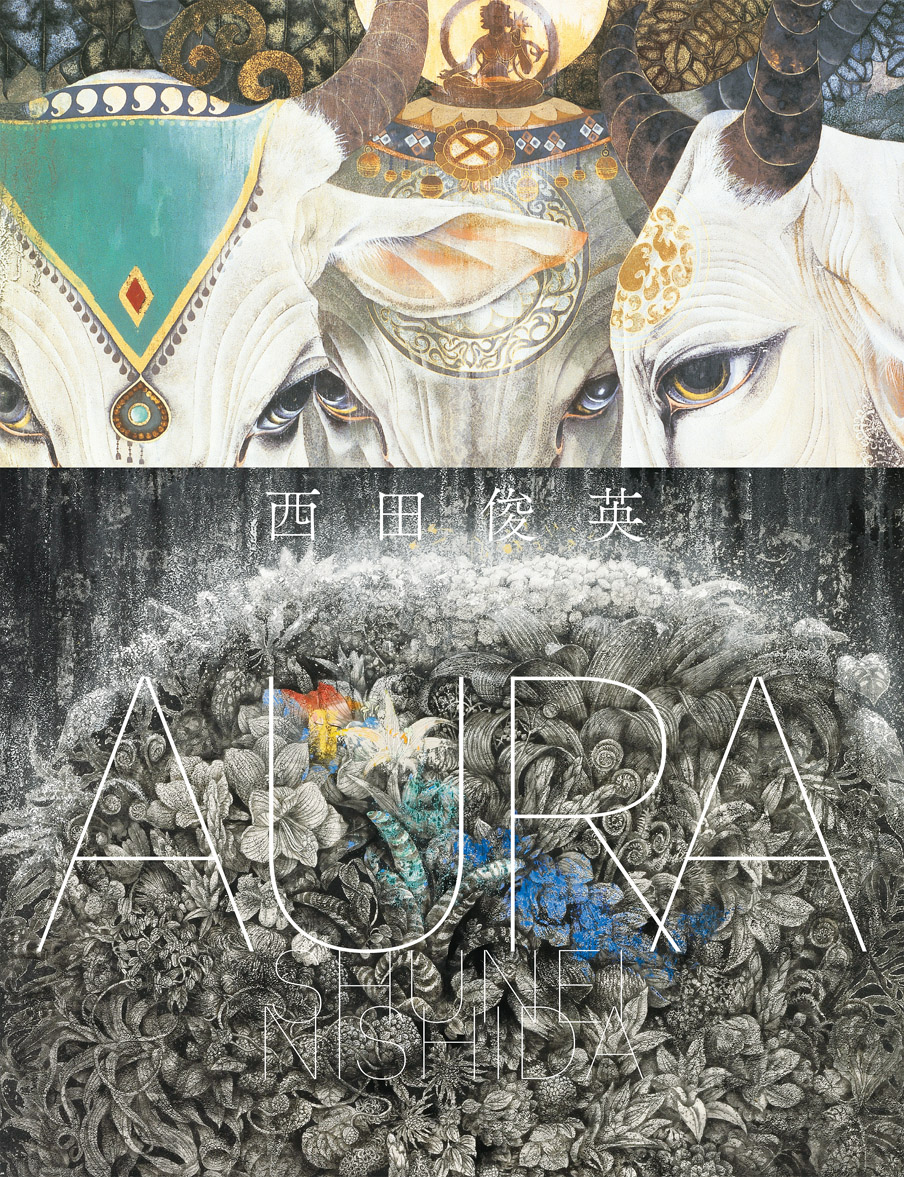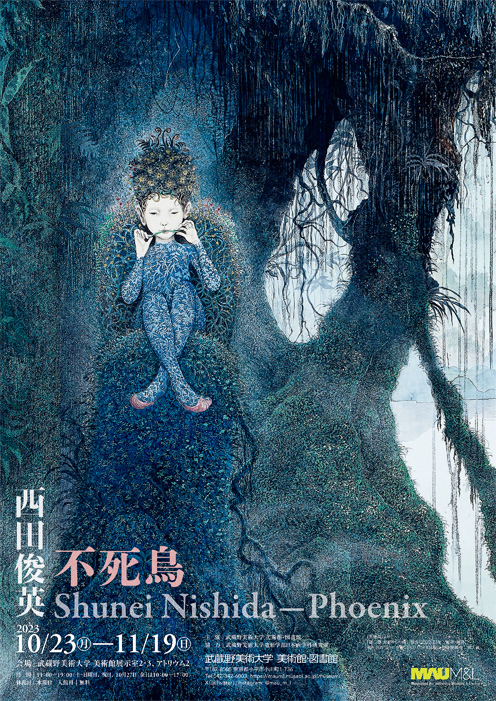
西田俊英『AURA』
発行:赤々舎 Size:H300mm x W230mm Page:220 pages Binding:Hardcover Published in October 2023 ISBN:978-4-86541-176-8 |
¥ 7,000+tax
国内送料無料! お支払い方法は、PayPal、PayPay、Paidy 銀行振込、郵便振替、クレジットカード支払いよりお選び頂けます。 |
|---|
About Book
風景の深度と共振し、存在を観る画業の集大成
AURA
Shunei Nishida
This title "AURA" features the representative works of Japanese painter Shunei Nishida, who continues to paint while treading on a single path, along with his latest work based on the primeval forests of Yakushima Island.
Born near the pristine forests of Ise Grand Shrine and mentored by Togyu Okumura, his lodestar, and Hideo Shiode, an exemplar of the conscience of a painter, Nishida has been guided by everything in the natural world, from a single drop of clear water and the stars in the night sky to the microorganisms beneath fallen leaves. His deep connection to nature allows him to depict the spirituality and universality of the world, including the intangible and the fantastical, expressing the beauty of existence.
There was a period when Nishida, who had fallen into an artistic slump, and avoiding people, he secluded himself around Mt. Tanigawa to immerse himself in sketches. Up to then, Nishida had relied on his imagination for his paintings, but in this period, he recognized again the importance of realistic representation.
Nishida sketched everything he could think of -- landscapes, animals, people and so on -- awakening himself to their potential for art.
Since 2000, Nishida has contact with Japan's beautiful nature around Hiroshima and other areas in the Chugoku region and to attempt classical motifs such as cranes and cherry blossoms in his paintings. He also tried creating his own new style of bird-and-flower painting.
In 2022, he moved to Yakushima Island for a year, aspiring to create a 70-meter-long masterpiece that delves into the island's history, the cycle of life, and the impacts of logging and development on the pristine forests. A work in progress titled "The Phoenix" reflects everything in the environment, with a meticulous and free brush, and it questions the relationship between nature and humans.
Praying is painting - this book is a culmination of the artist history and view of the work world, where they resonate with each other.
------------
My mother was forever overworked. She spent her entire life only working without respite. For me, growing up seeing my mother work like that, I think of painting itself as work. Painting is often demanding but I believe that is what working is. If I murmur that I want to take a rest, I then feel someone is telling me: "Well, in that case, give up being a painter." I have vowed that I will follow the same path as my mother. I should just do my job and work. I believe if I do so, someday I will be able to create a work that strikes the heart. Has it come? To you.
------------
My mentor, Hideo Shiode, said: "Personality is never about being different from others. It is just a matter of becoming yourself." His disciple, I have relied on those words and not tried to have a distinctive personality. I have come to believe that a personality unnaturally made is only bluster and without any value. Sensei! Have I become my true self? Having entered the later stage of my life, am I painting the pictures that are really me? My mentor also told me: "A painting is not created with a brush. It is not painted by your hand." "Well, then how do I paint?" I muttered to myself when I was young. I thought that I could create a masterpiece by myself if I bring to bear all my effort and talent. But before long, I found out that was not the case. I finally realized that a painting is only the expression of my true feelings and the catalyst that keeps me alive. "Don't forget your dreams and strive to learn," my mentor told me in the last years of his life, and I have lived my life cherishing those words. I really think painting is a difficult thing. I had no idea I would have to paint so much of what lies in my heart. That is precisely why I believe it is so valuable to continue putting into practice the lessons from my mentor.
------------
God dwells in every tree and blade of grass.
Nature lives on as it is.
Yet I feel that what is happening in our human society runs counter to what we desire. Our human-centered egotistic values....
We continue cutting down trees and destroying forests.
Isn't it more important for forests to continue to be forests?
What kind of paintings bring happiness to people?
There is still so much I don't know.
(Shunei Nishida)
Related Exhibiton
|
西田俊英 個展「不死鳥」 会期:2023年 10月23日(月)~11月19日(日) 時間:11:00〜19:00(※土日祝、及び10/27は10:00〜 17:00) 会場:武蔵野美術大学 美術館・図書館 東京都小平市小川町1-736(武蔵野美術大学 鷹の台キャンパス) 休館:水曜日 10月23日(月)、11月6日(月)特別対談 開催 【NHK Eテレ放送】日曜美術館 |
|
Artist Information
西田俊英(にしだ・しゅんえい)
Shunei Nishida
Born in 1953 in Ise City in Mie Prefecture.
When he was a junior high school student, Nishida became a private pupil of the Western-style painter Kusuaki Kori.
In high school, he focused on monochromatic painting, and he was the youngest painter in Japan to be selected to show a work at the Shunyo Art Exhibition and to receive the Chubu Shunyo-kai Art Society Award, given for his painting Moonlight.
In 1973, Nishida entered the Department of Japanese Painting at Musashino Art University. While still a student, Nishida's paintings were selected for successive Nihon Bijutsuin's "Inten Exhibitions." After graduating, he continued his training under Togyu Okumura, his lodestar, and Hideo Shiode, an exemplar of the conscience of a painter.
In 1983, received the Yamatane Museum of Art Exhibition's Prize for Excellence for his painting Keman (Buddhist ritual flower decorations) depicting the transmigration of souls, which was inspired by his travel to India. The following year, he received the Grand Prize at the Tokyo Central Museum's Japanese Painting Grand Prix Exhibition for his painting Seigyu (Sacred cow), which depicts a sacred Indian white cow.
in 1993, he moved with his family for a year to India, which he had been visiting nearly every year, as an overseas researcher dispatched by the Agency for Cultural Affairs.
Back in Japan, in 1995, won the Inten Taikan Award, the First Adachi Museum Award and other awards for his painting Pushkar no Rojin (Old man of Pushkar).
Nishida also made many research trips to Western Europe, and he won his second Inten Taikan Award for his painting of a driver in Spain titled Carlos. In 1998, he was named a member of the Japan Art Institute.
in 2000, Becoming a professor at Hiroshima City University
In 2002, Nishida had his first one-man exhibition at the Nihonbashi Mitsukoshi Main Store, and had a retrospective exhibition at Imai Museum. Since then, he has had solo exhibitions nearly every year at major department stores, museums, and elsewhere.
In 2012, Nishida won the MOA Okada Mokichi Grand Prize for his painting Hyou- Hyou Kai-Kai (Boisterous sea), which depicts solitary pine trees surviving amidst the harsh conditions and rough waters of Sea of Japan.
In 2017, he was awarded the Japan Art Academy Prize for his Mori no Sumibito (Forest dweller), which takes Yakushima Island as its motif. In the same year he was named a member of the Japan Art Academy.
In 2022, Nishida took a sabbatical leave from Musashino Art University, where he teaches, and relocated for one year to Yakushima Island, where he set up his atelier and painted to his heart's content.
Main public collections
Adachi Museum of Art; Tenshin Memorial Museum of Art, Ibaraki; Imai Museum; Ministry of Foreign Affairs, Japan; Kitakyushu Municipal Museum of Art; Kitazawa Museum; Sakura City Museum; Sato Sakura Museum; Simose Art Museum; Jingu Art Museum; Zojo-ji Temple; Tokyo Opera City Art Gallery; National Museum of Modern Art, Tokyo; Nara Prefecture Complex of Man'yo Culture; Narukawa Art Museum, Hakone; Hirano Museum; Hiroshin Cultural Foundation; Mie Prefectural Art Museum; Yakushi-ji Temple; Yamatane Museum of Art; Rokucho Museum Flora, etc. (In Japanese syllabic order)








